
Ulysses S. Grant National Historic Site is a 9.65-acre (3.91 ha) United States National Historic Site located 10 miles (16 km) southwest of downtown St. Louis, Missouri, within the municipality of Grantwood Village. The site, also known as White Haven, commemorates the life, military career, and presidency of Ulysses S. Grant. Five historic structures are preserved at the site, including the childhood home of Ulysses' wife, Julia Dent Grant.

Highland, formerly Ash Lawn–Highland, located near Charlottesville, Virginia, United States, and adjacent to Thomas Jefferson's Monticello, was the estate of James Monroe, fifth president of the United States. Purchased in 1793, Monroe and his family permanently settled on the property in 1799 and lived at Highland for twenty-five years. Personal debt forced Monroe to sell the plantation in 1825. Before and after selling Highland, Monroe spent much of his time living at the plantation house at his large Oak Hill estate near Leesburg, Virginia.
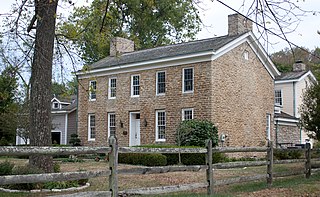
The Elliott House is a historic residence in the city of Indian Hill in northeastern Hamilton County, Ohio, United States. Constructed in 1802, this farmhouse once served as the hub of an industrial operation, and since that time it has been named a historic site.

The Riddle–Friend House is a historic residence in Wyoming, Ohio. Constructed in the early nineteenth century, it has been home to some of the area's earliest residents, and it has been named a historic site as a rare survivor of the city's earliest years.

Roudebush Farm is a historic farmstead located southeast of Harrison in northwestern Hamilton County, Ohio, United States. It was established in the 1850s with the construction of a small frame residence. This building, the original farmhouse, was built just one story tall and composed of two rooms. The builder was the farm's namesake, Hammand Hersh Roudebush.

The William Stearns House is a historic residence in the city of Wyoming, Ohio, United States, near Cincinnati. Built at the turn of the twentieth century, it was the home of a business baron, and it has been designated a historic site.

The John Tangeman House is a historic house in the city of Wyoming, Ohio, United States. The city's best house of its style, the residence was once home to a prosperous factory owner, and it has been named a historic site.
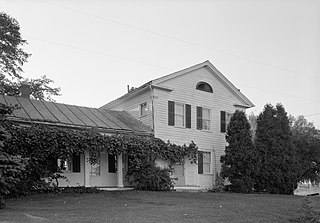
The Darlon Allen House is a historic residence located near Wellington in southern Lorain County, Ohio, United States. One of the most significant farmhouses in an area known for its historically important architecture, it has been named a historic site.

The Kennedy Farm is a National Historic Landmark property on Chestnut Grove Road in rural southern Washington County, Maryland. It is notable as the place where the radical abolitionist John Brown planned and began his raid on Harpers Ferry, Virginia, in 1859. Also known as the John Brown Raid Headquarters and Kennedy Farmhouse, the log, stone, and brick building has been restored to its appearance at the time of the raid. The farm is now owned by a preservation nonprofit.

The John P. Parker House is a historic house museum at 300 North Front Street in Ripley, Ohio. It was home to former slave and inventor John P. Parker (1827–1900) from 1853 to his death in 1900. Parker was an abolitionist and a well-documented conductor on the Underground Railroad, helping hundreds of escaped slaves. The house was listed on the National Register of Historic Places in 1980, and it was further designated a National Historic Landmark in 1997. It is now owned and managed by a local nonprofit organization as a museum about Parker's life and the abolitionist movement.
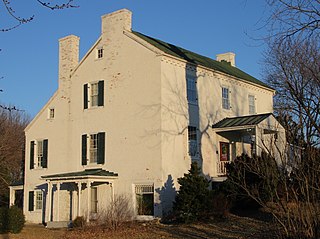
Rock Spring is a historic farmstead property near Shepherdstown, West Virginia.

The Daniel Howell Hise House is an historic home that was part of the Underground Railroad. It is listed on the National Register of Historic Places and is located in Salem, Ohio.

The Landmark Inn State Historic Site is a historic inn in Castroville, Texas, United States. It serves the general public as both a state historic site and a bed & breakfast with eight overnight rooms.
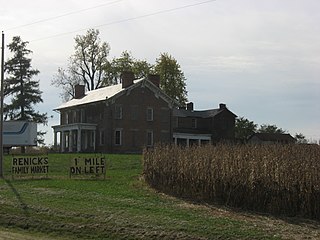
The Renick Farm is a historic farmstead located along U.S. Route 23 near the village of South Bloomfield in northern Pickaway County, Ohio, United States. Composed of six buildings dating back to 1830, the farmstead has been designated a historic site because of its unusually well-preserved architecture.

Henderson Hall Historic District is a National Register of Historic Places (NRHP)-listed historic district in Wood County, West Virginia. The primary contributing property is Henderson Hall, a home in the Italianate style from the first half of the 19th century. Other residences at the site are a tenant house from the end of the 19th century, and "Woodhaven", the 1877 home of Henry Clay Henderson. Additional structures include a smokehouse, two corn cribs, a carriage barn that also served as a schoolhouse, a scale house used for storing agricultural equipment, and two barns. Also included within the district are the 19th-century Henderson family cemetery, a wall, a mounting block, and three mounds associated with the pre-Columbian Adena culture.
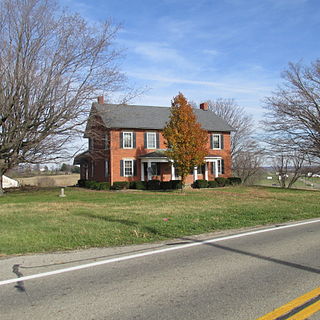
The Stevenson Peters House is a historic farm complex near the city of Circleville in Pickaway County, Ohio, United States. Built in the mid-19th century, the complex has been named a historic site.

The Rawlings-Brownell House is a historic residence on the northern side of Washington Court House, Ohio, United States. Built during the middle of the nineteenth century, it was home to the man who established the neighborhood in which it is located, and it was later the home of a leading merchant. Although constructed in one architectural style, it was later partially converted into another style, becoming a good example of changes in the community's architectural tastes. It has been designated a historic site.
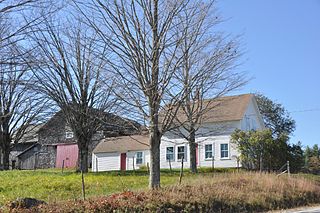
The Hersey Farms Historic District of Andover, New Hampshire, includes two farmsteads belonging to members of the Hersey family, located on the Franklin Highway in eastern Andover. The older of the two farms, the Guy Hersey Farm, was established c. 1850 by Hiram Fellows, and has been in the Hersey family since 1904. The adjacent James Hersey Farm was established in 1833 by Alfred Weare, and was acquired by Guy Hersey's son James in 1945. The two farms encompass 325 acres (132 ha), and were listed on the National Register of Historic Places in 2008.

The Captain Enoch Remick House is part of a historic homestead located in the town of Tamworth, New Hampshire, United States. In 1996, the house—along with a complex of five surrounding outbuildings and approximately 69 acres (28 ha) of field, pasture and woodland—was listed on the National Register of Historic Places for its significance in art, architecture, and local agriculture. It now operates under the auspices of the Remick Country Doctor Museum & Farm.

The Ruth Stone House is a historic house at 788 Hathaway Road in Goshen, Vermont. This 19th-century farmhouse was for many years the home of poet Ruth Stone (1915-2011). Since her death, the property has been taken over by the Ruth Stone Foundation, established in 2013 to manage her legacy. The organization's intent is to establish the house as a writer's retreat. It was listed on the National Register of Historic Places in 2016.






















